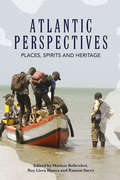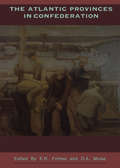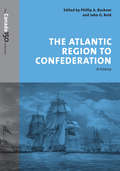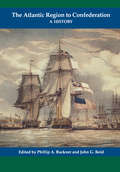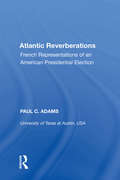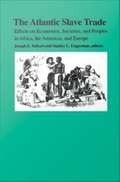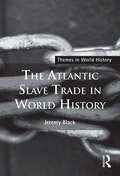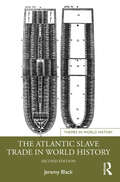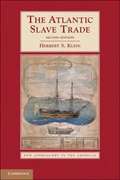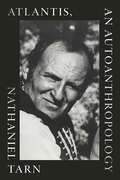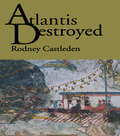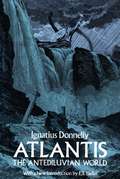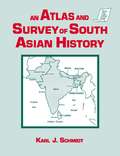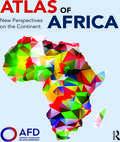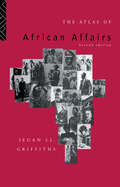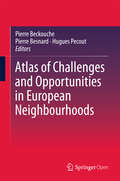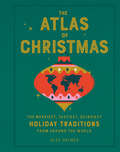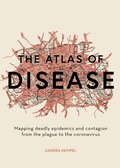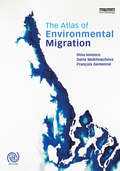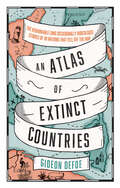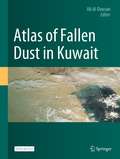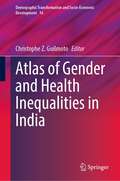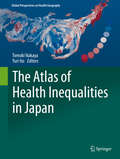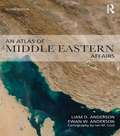- Table View
- List View
Atlantic Perspectives: Places, Spirits and Heritage
by Markus Balkenhol Ruy Llera Blanes Ramon SarróFocusing on mobility, religion, and belonging, the volume contributes to transatlantic anthropology and history by bringing together religion, cultural heritage and placemaking in the Atlantic world. The entanglements of these domains are ethnographically scrutinized to perceive the connections and disconnections of specific places which, despite a common history, are today very different in terms of secular regimes and the presence of religion in the public sphere. Ideally suited to a variety of scholars and students in different fields, Atlantic Perspectives will lead to new debates and conversations throughout the fields of anthropology, religion and history.
The Atlantic Provinces in Confederation
by E. R. Forbes D. A. MuiseCanada's four easternmost provinces, while richly diverse in character and history, share many elements of their political and economic experience within Confederation. In this volume thirteen leading historians explore the shifting tides of Atlantic Canada's history, beginning with the union of Nova Scotia and New Brunswick with Ontario and Quebec to form the Dominion in 1867. Continuing on through Prince Edward Island's entry into Confederation six years later and Newfoundland's in 1949, they take the story of Atlantic Canada up to the 1980s.Collectively their work sheds light on the complex political dynamic between the region and Ottawa and reveals the roots of current social and economic realities. Fragmentation versus integration, plenty versus scarcity, centre versus periphery, and other models inform their analysis.The development of regional disparity, and responses to it, form a major theme. The tradition of regional protest by Maritimers, and later Atlantic Canadians, runs deep; so does their commitment to the idea of an integrated Canadian nation. Protests, over the decades, have primarily been expressions of frustration at perceived exclusion from the full benefits of national union. The creation of national markets for labour, capital, and goods often operated to their detriment, and political decisions at the national level frequently reinforced rather than alleviated the regional predicament.More than an account of the wealthy and powerful, this book often places ordinary men and women at the centre of the story. Above all, it reveals the resilience of Atlantic Canadians as they have struggled to overcome their problems and to share in the benefits of life in the Canadian community.
The Atlantic Region to Confederation: A History
by John Reid Phillip BucknerNearly thirty years ago W.S. MacNutt published the first general history of the Atlantic provinces before Confederation. An outstanding scholarly achievement, that history inspired much of the enormous growth of research and writing on Atlantic Canada in the succeeding decades. Now a new effort is required, to convey the state of our knowledge in the 1990s. Many of the themes important to today's historians, notably those relating to social class, gender, and ethnicity, have been fully developed only since 1970. Important advances have been made in our understanding of regional economic developments and their implications for social, cultural, and political life.This book is intended to fill the need for an up-to-date overview of emerging regional themes and issues. Each of the sixteen chapters, written by a distinguished scholar, covers a specific chronological period and has been carefully integrated into the whole. The history begins with the evolution of Native cultures and the impact of the arrival of Europeans on those cultures, and continues to the formation of Confederation. The goal has been to provide a synthesis that not only incorporates the most recent scholarship but is accessible to the general reader. The book re-assesses many old themes from a new perspective, and seeks to broaden the focus of regional history to include those groups whom the traditional historiography ignored or marginalized.
The Atlantic Region to Confederation: A History
by John G. Reid Phillip BucknerNearly thirty years ago W.S. MacNutt published the first general history of the Atlantic provinces before Confederation. An outstanding scholarly achievement, that history inspired much of the enormous growth of research and writing on Atlantic Canada in the succeeding decades. Now a new effort is required, to convey the state of our knowledge in the 1990s. Many of the themes important to today's historians, notably those relating to social class, gender, and ethnicity, have been fully developed only since 1970. Important advances have been made in our understanding of regional economic developments and their implications for social, cultural, and political life.This book is intended to fill the need for an up-to-date overview of emerging regional themes and issues. Each of the sixteen chapters, written by a distinguished scholar, covers a specific chronological period and has been carefully integrated into the whole. The history begins with the evolution of Native cultures and the impact of the arrival of Europeans on those cultures, and continues to the formation of Confederation. The goal has been to provide a synthesis that not only incorporates the most recent scholarship but is accessible to the general reader. The book re-assesses many old themes from a new perspective, and seeks to broaden the focus of regional history to include those groups whom the traditional historiography ignored or marginalized.
Atlantic Reverberations: French Representations of an American Presidential Election
by Paul C. AdamsThe 2004 US election provided French citizens and their media with a springboard for re-conceiving 'self' and 'other'. Given its prominent opposition to recent US foreign policy such as the invasion of Iraq, a volley of insults and caustic remarks reverberated between France and the US. French observers linked the Bush administration's policies to particular groups and regions within the US, to a democratic deficit, to a perceived threat of US collapse and to the need for a stronger Europe. By examining how the French media - newspapers, television, the internet and scholarly research - represented the election from a critical geopolitical perspective, this book provides the first major in-depth study of views of the US in contemporary foreign media.
The Atlantic Slave Trade: Effects on Economies, Societies, and Peoples in Africa, the Americas, and Europe
by Joseph E. Inikori Stanley L. EngermanDebates over the economic, social, and political meaning of slavery and the slave trade have persisted for over two hundred years. The Atlantic Slave Trade brings clarity and critical insight to the subject. In fourteen essays, leading scholars consider the nature and impact of the transatlantic slave trade and assess its meaning for the people transported and for those who owned them. Among the questions these essays address are: the social cost to Africa of this forced migration; the role of slavery in the economic development of Europe and the United States; the short-term and long-term effects of the slave trade on black mortality, health, and life in the New World; and the racial and cultural consequences of the abolition of slavery. Some of these essays originally appeared in recent issues of Social Science History; the editors have added new material, along with an introduction placing each essay in the context of current debates. Based on extensive archival research and detailed historical examination, this collection constitutes an important contribution to the study of an issue of enduring significance. It is sure to become a standard reference on the Atlantic slave trade for years to come. Contributors. Ralph A. Austen, Ronald Bailey, William Darity, Jr. , Seymour Drescher, Stanley L. Engerman, David Barry Gaspar, Clarence Grim, Brian Higgins, Jan S. Hogendorn, Joseph E. Inikori, Kenneth Kiple, Martin A. Klein, Paul E. Lovejoy, Patrick Manning, Joseph C. Miller, Johannes Postma, Woodruff Smith, Thomas Wilson
The Atlantic Slave Trade in World History (Themes in World History)
by Jeremy BlackIn The Atlantic Slave Trade in World History, Jeremy Black presents a compact yet comprehensive survey of slavery and its impact on the world, primarily centered on the Atlantic trade. Opening with a clear discussion of the problems of defining slavery, the book goes on to investigate the Atlantic slave trade from its origins to abolition, including comparisons to other systems of slavery outside the Atlantic region and the persistence of modern-day slavery. Crucially, the book does not ask readers to abandon their emotional ties to the subject, but puts events in context so that it becomes clear how such an institution not only arose, but flourished. Black shows that slavery and the slave trade were not merely add-ons to the development of Western civilization, but intimately linked to it. In a vital and accessible narrative, The Atlantic Slave Trade in World History enables students to understand this terrible element of human history and how it shaped the modern world.
The Atlantic Slave Trade in World History (Themes in World History)
by Jeremy BlackNow in its second edition, The Atlantic Slave Trade in World History has been updated to include recent scholarship, and an analysis of how debates have changed in light of recent key events such as the Black Lives Matter movement.Primarily focused on the Atlantic Slave Trade, this study places slavery within a broader world context and includes significant detailed coverage of Africa. With a chronological approach, it guides students through the origins of the Atlantic Slave Trade to its expansion and eventual abolition. Its final chapters explore the legacy of the Atlantic Slave Trade by comparing it to other systems of slavery outside of the Atlantic region, and analyze the persistence of modern-day slavery. As well as offering an analysis of historiography, the updated bibliography and conclusion, which considers the recent Black Lives Matter protests and their aftermath, provide a fresh account of how slavery has shaped our understanding of the modern world.Unmatched in its breadth of information, chronological sweep, and geographical coverage, The Atlantic Slave Trade in World History is the most useful introductory resource for all students who study the Atlantic Slave Trade in a world context.
The Atlantic Slave Trade Second Edition
by Herbert S. KleinThis survey is a synthesis of the economic, social, cultural, and political history of the Atlantic slave trade, providing the general reader with a basic understanding of the current state of scholarly knowledge of forced African migration and compares this knowledge to popular beliefs. The Atlantic Slave Trade examines the four hundred years of Atlantic slave trade, covering the West and East African experiences, as well as all the American colonies and republics that obtained slaves from Africa. It outlines both the common features of this trade and the local differences that developed. It discusses the slave trade's economics, politics, demographic impact, and cultural implications in relationship to Africa as well as America. Finally, it places the slave trade in the context of world trade and examines the role it played in the growing relationship between Asia, Africa, Europe, and America. This new edition incorporates the latest findings of the last decade in slave trade studies carried out in Europe and America. It also includes new data on the slave trade voyages which have just recently been made available to the public.
Atlantis, an Autoanthropology
by Nathaniel TarnOver the course of his long career, Nathaniel Tarn has been a poet, anthropologist, and book editor, while his travels have taken him into every continent. Born in France, raised in England, and earning a Ph.D. from the University of Chicago, he knew André Breton, Salvador Dalí, Marcel Duchamp, Margot Fonteyn, Charles Olson, Claude Lévi-Strauss, and many more of the twentieth century’s major artists and intellectuals. In Atlantis, an Autoanthropology he writes that he has "never (yet) been able to experience the sensation of being only one person.” Throughout this literary memoir and autoethnography, Tarn captures this multiplicity and reaches for the uncertainties of a life lived in a dizzying array of times, cultures, and environments. Drawing on his practice as an anthropologist, he takes himself as a subject of study, examining the shape of a life devoted to the study of the whole of human culture. Atlantis, an Autoanthropology prompts us to consider our own multiple selves and the mysteries contained within.
Atlantis Destroyed
by Rodney CastledenPlato's legend of Atlantis has become notorious among scholars as the absurdest lie in literature. Atlantis Destroyed explores the possibility that the account given by Plato is historically true. Rodney Castleden first considers the location of Atlantis re-examining two suggestions put forward in the early twentieth century; Minoan Crete and Minoan Thera. He outlines the latest research findings on Knossos and Bronze Age Thera, discussing the material culture, trade empire and agricultural system, writing and wall paintings, art, religion and society of the Minoan civilization. Castleden demonstrates the many parallels between Plato's narrative and the Minoan Civilization in the Aegean.Fired by the imagination a new vision of Atlantis has arisen over the last one hundred and fifty years as a lost utopia. Rodney Castleden discusses why this picture arose and xplains how it has become confused with Plato's genuine account.
Atlantis, the Antediluvian World
by Ignatius DonnellyThe great classic of Atlantis, this book more than any other established the existence of this lost continent for the modern world. Attracting hundreds of thousands of readers and stimulating vast debate, it influenced generations of people including countless scientists who went on to do serious work in their fields, and numerous science-fiction writers. It is a measure of the power of the Atlantis myth that, despite all the evidence to the contrary, the idea of a submerged Atlantic Ocean continent remains vigorous today, long after Donnelly's work first appeared.A lawyer and politician before he turned to writing, Ignatius Donnelly (1831-1901) spent many years amassing evidence for his book on Atlantis. Displaying an immense knowledge of Platonic and Biblical material, comparative archeological discoveries, folk traditions of deluges, and geological data supporting catastrophic volcanic activity, Donnelly staggered his readers with "facts" and overwhelmed them with his many brilliant arguments. Despite the many more recent discoveries that have proved many of his "facts" to be false, his arguments still dazzle and his central myth continues to fascinate. The highly appealing idea of a lost continent with a high civilization, one that was the mother of all other civilizations, is one of the most enduring of all human myths and shows no signs of disappearing.A seminal work on Atlantis and a classic in the history of culture, this book is the starting point for anyone sincerely interested in the Atlantis myth. Still the most readable and imaginative of the books on Atlantis, it is a work that will long outlive most of the more recent accounts. As a study of the golden past, it is an enormously intriguing and enjoyable book.
An Atlas and Survey of South Asian History (Sources And Studies In World History Ser.)
by Karl J. SchmidtThis historical atlas is devoted primarily to India, Bangladesh and Pakistan, while also covering Napal, Bhutan and Ceylon/Sri Lanka. The maps are accompanied by text which illuminates recent political, economic, social and cultural developments.
Atlas of Africa: New Perspectives on the Continent
by Agence Française de Développement Dunod EditeurThis innovative Atlas of Africa, by the Agence Française de Développement, offers comprehensive insights into contemporary Africa through the use of full-colour maps, charts, graphics and text which demonstrate and explain Africa’s growing importance in the world and its demographic, economic, social and environmental transformation, while also outlining the challenges that the continent faces. The three sections, offering new perspectives on the continent, comprise: Taking Full Measure of Africa – examining the major economic, demographic, social and political transformations that Africa has undergone in a short space of time. A Multifaceted Continent with Shared Challenges – looking at the major intraregional economic, demographic, environmental and social dynamics that are currently shaping the continent. Africa Inventing Itself and Taking up the Key Challenges of Tomorrow – an overview of the challenges that Africa is currently facing and will need to face in the future, including the environment and climate change, social cohesion and demographic issues, economic development and governance. Full-colour maps, charts and graphics cover such wide-ranging topics as economic development, urbanization, education, the rule of law, gender, the blue economy, regional organizations, energy and culture, to form a volume which offers a wide-ranging overview in graphic form of Africa in the world today, of interest to all those studying, working in or with Africa, and those with a general interest in the continent.
The Atlas of African Affairs
by Ieuan L.l. GriffithsThe Atlas of African Affairs is divided into five sections dealing with environmental, historical, political and economic issues and with Southern Africa. Throughout, the book presents an interdisciplinary, integrated perspective on African affairs. Most of the chapters deal with continent-wide themes and are illustrated by maps of Africa as a whole drawn to a standardised outline of the same map projection and scale. Other chapters, often by way of example, discuss parts of the continent or individual countries and are illustrated with appropriate maps. The basic format of integrated text and maps is supplemented by guides to further reading at the end of each section as well as a series of detailed statistical tables at the end of the book.
The Atlas of Beauty: Women of the World in 500 Portraits
by Mihaela NorocBased on the author's online photography project, this stunning collection features portraits of 500 women from more than 50 countries, accompanied by revelatory captions that capture their personal stories. Since 2013 photographer Mihaela Noroc has traveled the world with her backpack and camera taking photos of everyday women to showcase the diversity of beauty all around us. The Atlas of Beauty is a collection of her photographs celebrating women from all corners of the world, revealing that beauty is everywhere, and that it comes in many different sizes and colors. Noroc's colorful and moving portraits feature women in their local communities, ranging from the Amazon rainforest to London city streets, and from markets in India to parks in Harlem, visually juxtaposing the varied physical and social worlds these women inhabit. Packaged as a gift-worthy, hardcover book, The Atlas of Beauty presents a fresh perspective on the global lives of women today.
Atlas of Challenges and Opportunities in European Neighbourhoods
by Pierre Beckouche Pierre Besnard Hugues PecoutThis atlas provides a macro-regional overview of the areas that surround the European Union, from the Sahara to the Middle East, Western Balkans to European Russia, Turkey to the Arctic. Detailing key socio-economic data as well as developmental trends, the maps provide a comprehensive territorial analysis at a local scale and explore the potential for regional integration and cooperation. These pioneering maps examine challenges that threaten this wide, yet inter-connected, region, including environmental concerns in the North, political unrest in the East, social factors in the Western Balkans, and the upheaval in the Mediterranean since the Arab spring. Coverage investigates such key countries and areas as Libya, Israel, Palestine, Syria, and the Ukraine as well as explores such essential issues as Europe's energy procurement. In addition, it also presents a comparison with other world regions such as East Asia and North America. In the end, readers discover that territorial integration faces many shortcomings, but that deep regional cooperation would be a key driver for the EU's sustainable future. This atlas features the main results of the "Integrated Territorial Analysis of the Neighbourhoods" research project undertaken by ESPON (The European Observation Network for Territorial Development and Cohesion). It provides scholars; local authorities and NGOs involved in cross-border cooperation; companies interested in energy, agriculture, water, transportation and communication; and interested readers with key insights into this important region.
The Atlas of Christmas: The Merriest, Tastiest, Quirkiest Holiday Traditions from Around the World
by Alex PalmerDiscover the fascinating (and sometimes downright odd!) ways that people and nations celebrate the holiday season and share this festive compendium's unique traditions together with family and friends.Do you know that in Guatemala there's a "Burn the Devil" tradition to kick off the Christmas season, where revelers gather to set fire to devil-piñatas? In Sweden, a popular figure in Christmas traditions is the Yule Goat, a rowdy, menacing character who demands gifts. And in Japan, a big bucket of Kentucky Fried Chicken has become the classic Christmas Day feast. These and many other global Christmas traditions are featured here in this delightful book. From decorations and activities to feasts and special treats, there's a wide range of both lovely and unusual traditions from around the globe.
The Atlas of Disease: Mapping Deadly Epidemics and Contagion from the Plague to the Coronavirus
by Sandra Hempel“A pleasingly written lay person’s primer to disease epidemiology, as well as a gentle introduction to the social and cultural history of medicine.” —The BiologistIncludes extensive illustrationsBehind every disease is a story, a narrative woven of multiple threads—from the natural history of the disease to the tale of its discovery and its place in world events. The Atlas of Disease is the first book to tell these stories in a new and innovative way, interweaving new maps with contemporary illustrations to chart some of the world’s deadliest pandemics and epidemics.Sandra Hempel reveals how maps have uncovered insightful information about the history of disease, from the seventeenth-century plague maps that revealed the radical idea that diseases might be carried and spread by humans, to cholera maps in the 1800s showing the disease was carried by water, right up to the AIDs epidemic in the 1980s, and the more recent devastating Ebola outbreak. Crucially, The Atlas of Disease also explores how cartographic techniques have been used to combat epidemics by revealing previously hidden patterns. These are the stories of discoveries that have changed the course of history, affected human evolution, stimulated advances in medicine, and saved countless lives.“Ample and well-chosen pictures . . . In fact, it is the sort of book that one can leaf through, looking only at illustrations and maps, and so is suitable for the informed and curious lay reader . . . Healthcare professionals and historians should also find it of interest.” —British Society for the History of MedicineAcclaim for Sandra Hempel’s previous works of medical history“A real-life scientific thriller.” —Kirkus Reviews“Riveting.” —Daily Telegraph“Fascinating . . . [A] masterful combination of telling details, engrossing prose, and drama.” —Publishers Weekly (starred review)
The Atlas of Environmental Migration
by Dina Ionesco Daria Mokhnacheva François GemenneAs climate change and extreme weather events increasingly threaten traditional landscapes and livelihoods of entire communities the need to study its impact on human migration and population displacement has never been greater. The Atlas of Environmental Migration is the first illustrated publication mapping this complex phenomenon. It clarifies terminology and concepts, draws a typology of migration related to environment and climate change, describes the multiple factors at play, explains the challenges, and highlights the opportunities related to this phenomenon. Through elaborate maps, diagrams, illustrations, case studies from all over the world based on the most updated international research findings, the Atlas guides the reader from the roots of environmental migration through to governance. In addition to the primary audience of students and scholars of environment studies, climate change, geography and migration it will also be of interest to researchers and students in politics, economics and international relations departments.
An Atlas of Extinct Countries
by Gideon Defoe"Prisoners of Geography meets Bill Bryson: a funny, fascinating, beautifully illustrated—and timely—history of countries that, for myriad and often ludicrous reasons, no longer exist. “Countries are just daft stories we tell each other. They’re all equally implausible once you get up close.” Countries die. Sometimes it’s murder, sometimes it’s by accident, and sometimes it’s because they were so ludicrous they didn’t deserve to exist in the first place. Occasionally they explode violently. A few slip away almost unnoticed. Often the cause of death is either “got too greedy” or “Napoleon turned up.” Now and then they just hold a referendum and vote themselves out of existence. This is an atlas of 48 nations that fell off the map. The polite way of writing an obituary is: dwell on the good bits, gloss over the embarrassing stuff. This book refuses to do so, because these dead nations are so full of schemers, racists, and con men that it’s impossible to skip the embarrassing stuff. Because of this – and because treating nation-states with too much reverence is the entire problem with pretty much everything – these accounts are not concerned with adding to the earnest flag saluting in the world, however nice some of the flags might be."
Atlas of Fallen Dust in Kuwait
by Ali Al-DousariThis open access book serves as an atlas of deposited dust and dust storms in Kuwait in relation to local and global regions. It features a wealth of maps and images of dust storm trajectories in the region, together with detailed descriptions of the chemical and physical properties of fallen dust, including the amount, particle size, statistical parameters, spectra absorption, dust mineralogy, trace and major elements, organic matter, associated pollen, and radionuclides and connected pollutants. Given its scope, the book is a valuable resource for a broad range of researchers, including geologists, chemists, environmentalists, botanists, air quality specialists, nanotechnology scientists, and solar energy experts.
Atlas of Gender and Health Inequalities in India (Demographic Transformation and Socio-Economic Development #16)
by Christophe Z. GuilmotoHow will the world's largest population approach its inequality challenges? This volume addresses this question by unraveling different strands of India's emerging health and gender geographies. It is the first book to offer a comparative study of these disparities in India, stressing the deep interaction between health challenges and patriarchal features. Most themes explored in this book illustrate the entangled nature of the social and regional determinants of gender and health imbalances in India. Through its rich cartography of contemporary India, the book represents the first Atlas exploiting district-level figures drawn from the latest sociodemographic survey conducted in 2019-21. After an initial methodological synopsis, the book is built around twenty chapters—illustrated by 75 original maps, figures, and tables prepared by thirty authors—and concludes with a synthesis of India's spatial patterns. Chapters engage with major themes of gender and health inequalities and explore an array of innovative indicators such as access to menstrual hygiene, cesarean deliveries, health insurance, son preference in fertility, female landownership, patrilocal systems, hypertension, anemia, hysterectomy, girl-only or single-child families, or traditional contraception. Together, they provide an often surprising glimpse into the present and future of India's gender and health landscape, highlighting the considerable progress accomplished over the last two decades alongside persistent gaps and emerging issues.
The Atlas of Health Inequalities in Japan (Global Perspectives on Health Geography)
by Tomoki Nakaya Yuri ItoThis new health atlas of Japan presents a series of maps about the health of the contemporary Japanese population, i.e. detailed maps of health indicators in small areas using cartograms. This is the first comprehensive small-area based health atlas about contemporary Japan using vital statistics from 1995-2014. Each map is supplemented with concise explanations written by leading epidemiologists and health geographers in Japan. The book employs various cutting-edge methods in spatial epidemiology, Bayesian spatial smoothing for the reliable mapping of mortality indices, advanced cartographic transformations using the concept of aerial cartograms, and summary statistics of socioeconomic health inequalities. The atlas highlights geographical aspects of social gradients in health by comparing mortality maps with distribution of deprivation index during the recent long-lasting economic stagnation period of Japan known as the lost decades. This health atlas will be a useful resource for international comparisons between Japan and other advanced countries in terms of health and related socioeconomic disparities between regions. It will be of interest to public health practitioners, administrators, researchers and students working on health geography and public health.
An Atlas of Middle Eastern Affairs
by Ewan W. Anderson Liam D. AndersonThis revised and updated version of An Atlas of Middle Eastern Affairs provides accessible, concisely written entries on the most important current issues in the Middle East, combining maps with their geopolitical background. Offering a clear context for analysis of key concerns, it includes background topics, the position of the Middle East in the world and profiles of the constituent countries. Features include: Clearly and thematically organised sections covering the continuing importance of the Middle East, the background, fundamental concerns, the states and the crucial issues related to the area. Original maps integrated into the text, placing international issues and conflicts in their geographical contexts. Case studies and detailed analysis of each country, complete with relevant statistics and key facts. Coverage of fundamental considerations, such as: water shortage the petroleum industry conflicts and boundary issues A comprehensive further reading section, enabling students to cover the topic in more depth. Updated to include recent developments such as the "Arab Spring," this book is a valuable introduction to undergraduate students of political science and Middle East studies and is designed as a primary teaching aid for courses related to the Middle East in the areas of politics, history, geography, economics and military studies. This book is also an outstanding reference source for libraries and anyone interested in these fields.
